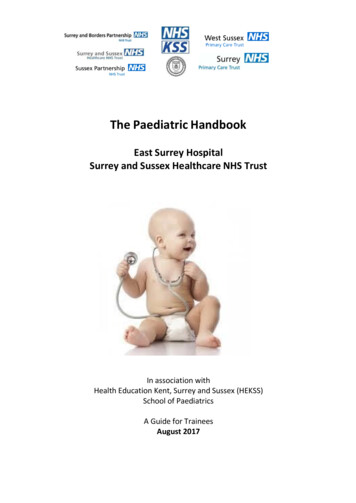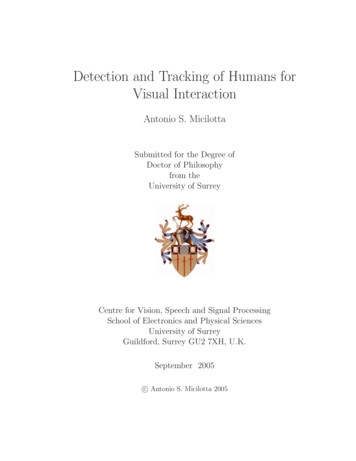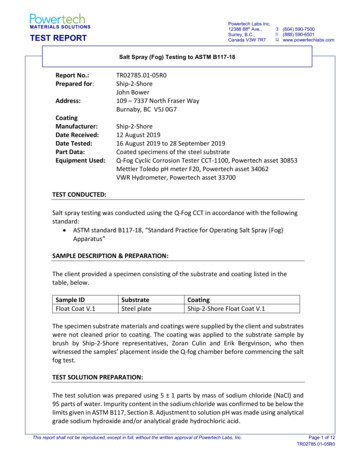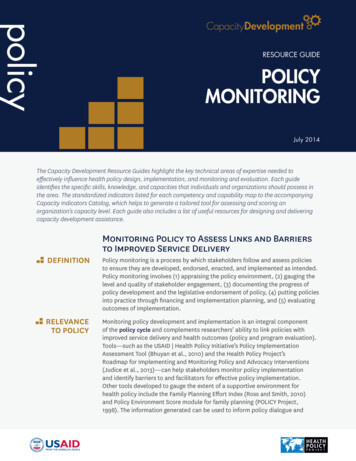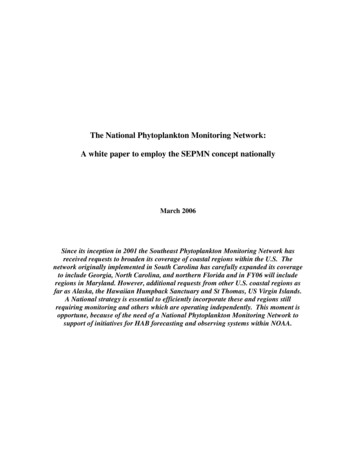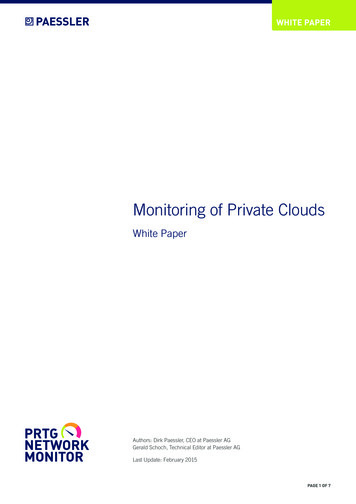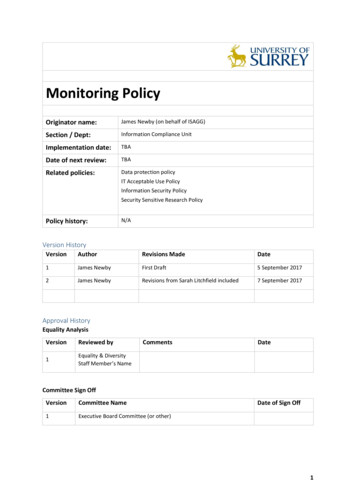
Transcription
Monitoring PolicyOriginator name:James Newby (on behalf of ISAGG)Section / Dept:Information Compliance UnitImplementation date:TBADate of next review:TBARelated policies:Data protection policyIT Acceptable Use PolicyInformation Security PolicySecurity Sensitive Research PolicyPolicy history:N/AVersion HistoryVersionAuthorRevisions MadeDate1James NewbyFirst Draft5 September 20172James NewbyRevisions from Sarah Litchfield included7 September 2017CommentsDateApproval HistoryEquality AnalysisVersionReviewed by1Equality & DiversityStaff Member’s NameCommittee Sign OffVersionCommittee Name1Executive Board Committee (or other)Date of Sign Off1
1IntroductionThe University respects the privacy of its staff and students and acknowledges that the private livesof individuals overlaps with their working lives. For example, the personal use of University emailaccounts and the internet at work is permitted provided it does not interfere with the properperformance of a staff member’s duties. Any automatic monitoring of employees and the computerequipment issued to them by the University risks privacy intrusion and will only be undertaken witha high level of justification and in appropriately controlled conditions.Any monitoring of specific individuals (targeted monitoring) will only be undertaken in exceptionalcircumstances, in appropriately controlled conditions and with adequate justification and oversight.The University also acknowledges that the filtering of access to certain websites might compromisethe ability of academic colleagues and students to undertake research freely. It must balance itssupport for academic freedom within the law against its obligation to protect the University and itsstaff/students from the risk of harm or legal action that might arise from accessing certain sites.Filtering, under appropriately controlled conditions, will therefore be allowed.1.1Purpose1.1.1This policy sets out the controls and rules to be followed for those undertaking any monitoring toensure that the privacy of all colleagues is appropriately protected and to protect the interests ofstaff engaged in monitoring who may discover activities amounting to misconduct so serious thatthey cannot reasonably be expected to ignore it.The policy aims to set expectations for staff on the degree of privacy they can expect when usingUniversity issued IT systems and equipment. The policy does not include rules or guidance on theuse of University issued IT equipment or required standards of staff conduct. For guidance on theuse of University issued IT equipment staff and students should review the IT Acceptable Use Policy.The policy also sets out the governance of filtering arrangements to ensure that those with alegitimate need to research external websites that would normally be blocked, have a mechanismto do so. The filtering that is implemented will prevent access only to those sites likely to containharmful and/or illegal material or giving rise to a risk that vulnerable people might be drawn intoillegal activity including terrorism.1.2Scope1.2.1This policy applies to all forms of monitoring including, but not limited to, the use of scanningsoftware to monitor system events and user behaviour. This may mean that staff in IT Services, whomanage the software which undertakes the monitoring, gain access to information about individualuser behaviour.No monitoring of staff activity on staff owned devices is permitted as these are considered entirelyprivate. However, staff owned devices using University networks may be monitored. The Universitywill normally co-operate with a lawful request to help law enforcement agencies investigate crime.Automated monitoring will apply to all those who use University systems so will include staff,students and others who may be given access to systems and networks.2
Targeted monitoring will apply only to University staff.Filtering will apply only to those sites identified as potentially harmful but will affect all usersincluding staff and students1.3Equality Analysis1.3.1TBA1.4Definitions1.4.1Automated monitoring – monitoring undertaken at the network level to identify system events oranomalies that might help identify, prevent or mitigate cyber attacks and other threats to theUniversity’s networks, systems and data.Targeted monitoring – monitoring aimed at a specific individual(s) to investigate conduct that maybreach University policies or the law.Filtering – the selective disabling of access to external websites.1.5Legislative context1.5.1This policy is informed by the requirements of the: Data Protection Act (until 25 May 2018)General Data Protection Regulations (from 25 May 2018)Regulation of Investigatory Powers Act (2000)1.6Health & Safety Implications1.6.1TBA2Policy2.1Principles2.1.1All members of staff should be aware that their use of University computing equipment may bemonitored. This monitoring may be automated or targeted.Although the technical solutions to enable monitoring may be available to staff, no monitoring willever be permitted because it is technically possible. All monitoring will be justified on the followinggrounds only:Automated monitoringThe University may undertake automated monitoring for the either of the following purposes: The effective and efficient planning and operation of IT facilitiesThe detection, mitigation and prevention of cyber threatsWhere automated monitoring reveals activity which the University cannot reasonably be expectedto ignore, the matter will be referred to Head of Security and SIRO (who may consult with DPO) who3
will decide whether the matter should be shared with enforcement agencies or whetherauthorisation for targeted monitoring should be obtained.Targeted monitoringNon automated (targeted) monitoring may be undertaken if criminal activity, which the Universitycannot reasonably be expected to ignore, is detected as a consequence of automated monitoring. Ifa student is alleged to have engaged in such activity, the University may report them to the policewho will determine the nature and scope if any subsequent investigation.Non automated (targeted) monitoring of IT facilities and systems issued to, and used by, staffmembers will only be undertaken to the extent permitted by or as required by law and as necessaryor justifiable for the following purposes: 2.1.2Detection and prevention of infringement of these and other policies and regulationsInvestigation of alleged misconductHandling email and other electronic communications during an employee’s extendedabsenceTo find lost messages or to retrieve messages lost due to computer failureTo comply with any legal obligationFilteringStaff and students wishing to view material on external websites whose access has been disabled bytargeted filtering should refer to the policy for Security Sensitive Research which outlines howaccess can be granted and any material acquired as a result should be stored. No attempt should bemade to circumvent the filters without following the procedures in the Security Sensitive Researchpolicy.2.2Procedures2.2.1Automated monitoring will be subject to the oversight of the Information Security and GovernanceSteering Group (ISAGG). However, there may be circumstances when automated monitoring isjustified and must be implemented urgently, for example in response to an ongoing cyber- attack orother threat to the security of the University’s networks, systems or data.Requests to undertake automated monitoring will be made by the Chief Information Officer (ornominee) to the Information Security and Governance Group (ISAGG) who will consider thepurposes of the monitoring and any privacy implications before granting approval. A privacy impactassessment (PIA) may be undertaken.When it is not possible or practicable to secure prior consent from ISAGG for automatedmonitoring, for example, when facing an immediate and serious cyber-attack, then the CIO mayauthorise automated monitoring without prior approval but should report fully to ISAGG at the nextavailable opportunity.Targeted monitoring must never be undertaken without explicit prior approval. Authorisation toconduct targeted monitoring will be granted by the VP HR or member of Executive Board. Anytargeted monitoring will be proportionate and reasonable steps will be taken to protect staffmembers’ private lives. The Senior Information Risk Officer and Data Protection Officer should beconsulted before approval is granted. The University will comply with lawful requests for4
information from law enforcement and government agencies for the purposes of detecting,investigating or preventing crime and ensuring national security.FilteringThe selective disabling of access to external websites will be implemented only by IT Services underthe direction of the Chief Information Officer. The list of disabled websites will be reported to ISAGGbut may be updated as required by the CIO.3Governance Requirements3.1Responsibility3.1.1The Chief Information Officer is responsible for ensuring that any automated monitoring usingtechnical measures is undertaken in compliance with this policy.The University Legal Counsel and Senior Information Risk Officer is responsible for assessing theprivacy implications of any automated or targeted monitoring and will take advice from the DataProtection Officer.The VP HR or other member of Executive Board are responsible for authorising any targetedmonitoring within the scope of this policy.The CIO is responsible for authorising the list of websites to be disabled as part of the University’sfiltering arrangements.The CIO is responsible for reporting to ISAGG on all automated monitoring and filteringimplemented by IT Services.ISAGG is responsible for approving the list of filtered websites under the filtering provisions of thispolicy and for approving any automated monitoring.3.2Implementation / Communication Plan3.2.1The key elements of this policy which require communication to all staff are included in the ITAcceptable Use policy. No campus wide communication of this policy is therefore required. Thepolicy will be published on the University policies website.3.3Exceptions to this Policy3.3.1As this policy outlines the procedures to follow to undertake any form of monitoring which meansthat, provided the appropriate conditions are in place, monitoring is possible. No exceptions to thepolicy are envisaged.3.4Supporting documentation3.4.1N/A5
1.4.1 Automated monitoring - monitoring undertaken at the network level to identify system events or anomalies that might help identify, prevent or mitigate cyber attacks and other threats to the University's networks, systems and data. Targeted monitoring - monitoring aimed at a specific individual(s) to investigate conduct that may
